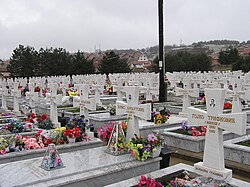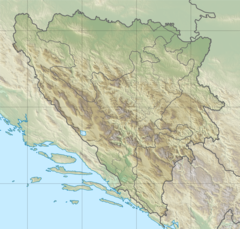|
Kravica attack (1993)
The Kravica attack was an attack on the Bosnian Serb village of Kravica by the Army of the Republic of Bosnia and Herzegovina (ARBiH) from the Srebrenica enclave on Orthodox Christmas Day, 7 January 1993. The attack was organized to coincide with the Serbian Orthodox Christmas, leaving the Serbs unprepared for any attack. 43-46 people died in the attack on the Serb side: 30-35 soldiers and 11-13 civilians.[1] The event is still marked by controversy. Republika Srpska claimed that all the homes were systematically torched by Bosniak armed group, but this could not be independently verified during the trial of Naser Orić by the ICTY, where the judges concluded that many houses were already previously destroyed during the war.[3] The civilian casualties in the village led to allegations by Serbia that Bosniak forces had carried out a massacre. Orić was acquitted of the charges relating to the killings, and later acquitted of all charges on appeal.[4] PreludeIn April 1992 in an effort to link up Serb-held territories in Bosnia-Herzegovina; eastern Bosnia, including the towns of Srebrenica and Bratunac, came under attack by Serbian and Bosnian Serb forces. The Serbs managed to seize Bratunac on 17 April and Srebrenica itself on 18 April 1992, which was followed by large scale massacres in early May. However, in early May 1992 a loose band of Bosniak forces under the command of Naser Orić - the local police commander - was able to drive Bosnian Serb forces out of Srebrenica and establish the town as a Bosnian government controlled enclave surrounded by Serb-held territory.[5] Srebrenica however remained besieged and in a state of near-starvation and Bosniak villages and towns around Srebrenica were under constant attack by Serb forces, which led the town to be flooded with refugees. The Bosnian Institute in the UK has published a list of 296 villages destroyed by Serb forces around Srebrenica three years before the genocide and in the first three months of war (April - June 1992):[6] According to the Naser Orić trial judgement:[7]
The attackOn 7 and 8 January 1993, Bosnian government soldiers attacked the Serb-inhabited village of Kravica. The Troops were from a number of villages within the Srebrenica enclave. At the time of the attack, there were a number of village guards and some Serb civilians in Kravica. Evidence shows that there was also Serb military presence in the area. The attack was met with resistance. Serbs fired artillery at the attacking Bosniaks from houses and other buildings; houses in the area were torched. Property was destroyed on a large scale. However, the evidence is unclear as to the number of houses that were wantonly destroyed by Bosniaks, as opposed to other causes.[8] Insight into the original documentation of the Army of the Republika Srpska (VRS) showed that military victims highly outnumbered the civilian ones. The document entitled "Warpath of the Bratunac Brigade", puts the military victims at 35 killed; the number of civilian victims of the attack is eleven.[1] Other sources place the victims at 43 killed, among them at least 13 civilians.[2] Aftermath Soon after the attack on Kravica, Serb forces launched a major offensive resulting in United Nations declaring Srebrenica a "safe area" where significant number of Bosnian government forces were hiding under command of Naser Orić. The controversy over the nature and number of the casualties came to a head in 2005, the 10th anniversary of the massacre.[9] According to Human Rights Watch, the ultra-nationalist Serbian Radical Party "launched an aggressive campaign to prove that Bosniaks had committed crimes against thousands of Serbs in the area" which "was intended to diminish the significance of the July 1995 crime."[9] In 2006, Orić appeared before the Trial Chamber of the International Criminal Tribunal for the former Yugoslavia (ICTY) in the Netherlands charged with a number of offences, including (in respect of Kravica) wanton destruction, and causing damage to civilian infrastructure, beyond the realm of military necessity. He was acquitted of this and a number of other charges in 2006[10] and acquitted of all charges by the Appeals Court in 2008.[11] Some Serbs, including Republika Srpska president Milorad Dodik, cite the Kravica attack as justification for the Srebrenica massacre.[12] Legal findingsThe Judgment in the case against Orić indicates that Kravica was a military base from which Serbs launched deadly attacks on neighbouring Bosnian Muslim villages and town of Srebrenica itself. The Bosniak counter-attack on Kravica on 7 January 1993 followed as a result of Serb blockade of humanitarian aid and constant attacks on nearby Bosnian Muslim villages. It was a response to earlier Serb attacks that occurred in December 1992.
The Judgment also confirms that Bosniak refugees in the besieged enclave started dying from starvation caused by the Serb blockade of humanitarian aid. As a result, Bosniaks had to counter-attack Serb military bases around Srebrenica to obtain much needed food and other necessities for the survival:
References
Documents
|
||||||||||||||||||||||
